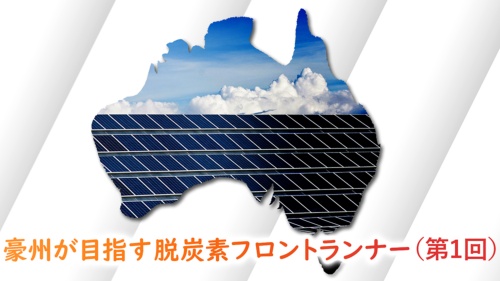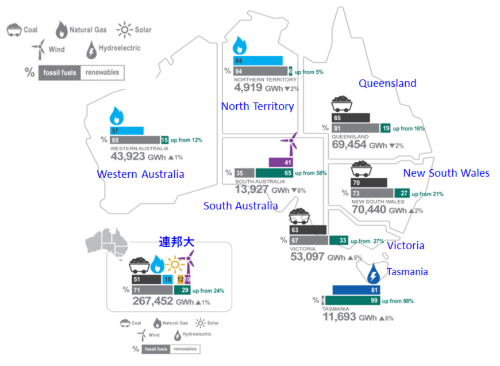Australia, a resource-rich country, tops the world in renewable energy introduction targets
Now, the focus should be on Australia. It is one of the world's leading coal-producing countries, and has been lagging behind in environmental policies until now. It has set the world's highest renewable energy introduction target. It has launched major policies to achieve this ambitious goal by the end of 2022, with business plans for renewable energy, storage, and hydrogen emerging one after another.
Therefore, I will explain Australia's decarbonization policy several times. The first is an overview of the energy situation. You can see that Australia is well positioned to achieve its lofty goals if the necessary policies are put in place.

(Source: 123RF)
Australia is rapidly increasing its renewable energy ratio and is on the verge of rising to the top of the world. The Labor Party's Anthony Albanyzy government, which came to power in May 2022 following the first change of government in nine years, has the world's most ambitious decarbonization policies.
The renewable energy ratio, which is currently around 30%, will be increased to 82% by FY2030. This is the world's highest, surpassing Germany's 80% reduction by 2030. It also plans to phase out most coal-fired power plants by 2040.
The former government's Liberal Party (conservative coalition with the National Party) has its support base in the coal and other fossil fuel industries, and has been criticized for its lack of enthusiasm for climate change countermeasures. In fact, Australia's renewable energy ratio in 2021 is 29% (including 6% hydropower), which is lower than in Europe and other countries, while coal is high at 52%. Australia was a latecomer to decarbonisation.
However, it is a leader in the introduction of grid storage batteries. At the time, the system's grid storage battery, which used Tesla's storage battery, which went into operation in November 2017, was the largest in the world. In addition, AEMO (Austrian Energy Market Operator), the operator of the electric power market, officially recognized grid storage batteries as inertia force, and signed a full-scale contract for the first time in the world.
Australia's electricity situation varies greatly from state to state
Before explaining the details, let's first check the basic information about Australia. Australia, although an island nation, is the sixth largest territory in the world after Russia, Canada, the United States, China and Brazil, and consists of six states and two territories.
The six states are New South Wales (NSW), Victoria (VIC), Queensland (QLD), Western Australia (WA), South Australia (SA), and Tasmania (TAS). The two territories are the Northern Territory (NT) and the Capital Territory (ACT), which includes the capital Canberra. ACT is located in New South Wales.
The population is about 26 million, concentrated in a certain area. It is a federal state and states have strong powers. Australia has a historical background that in 1901 six dominions were united and independent to form a federal state. Each state has a constitution, a prime minister, and a cabinet. The United States is also a federal state with strong state authority, but in Australia, the impression is that the state authority is even more powerful.
FY2021 electricity demand will be 70TWh in NSW, 69TWh in QLD, 53TWh in VIC, 44TWh in WA, 14TWh in SA, 12TWh in TAS, and 5TWh in NT.
Although the state's authority is strong, it is strongly influenced by the policy of the ruling party. Due to these circumstances, although the power supply mix differs greatly depending on the region, they all agree on the point of aiming for early decarbonization through the introduction of renewable energy and power storage equipment (details will be explained in the next section). Figure 1 shows the electricity situation in Australia in 2021 by state.

The power source composition is in line with resource availability
Figure 1 ● Electricity situation in Australia (2021) (Source: Australian Department of Climate Change, Energy, Environment and Water Resources “Australian Energy Update 2022”, blue text added by the author)
In 2021, the power supply mix for the entire Commonwealth will be 51% coal, 18% gas, 10% wind power, and 12% solar power. Renewable energy, including hydro power, is expanding rapidly from 24% in 2020 to 29%. In the three eastern states (QLD, NSW, VIC), coal accounts for 60% to 70%, SA accounts for two-thirds of renewable energy, TAS accounts for 81% hydropower, and WA/NT accounts for 60% to 80% gas. It is a composition ratio according to the existing situation. Although the renewable energy ratio varies greatly, it has increased compared to the previous year in all states.
Australia's power system has a nationwide wholesale market, with the NEM (National Energy Market) covering six eastern and central states (VIC, NSW, QLD, SA, TAS) and the independent system of Western Australia (WA ) and the Northern Territory (NT). In NEM, SA and TAS have narrow interconnection lines with other states, and there is concern that they may become isolated due to weather and other factors.






